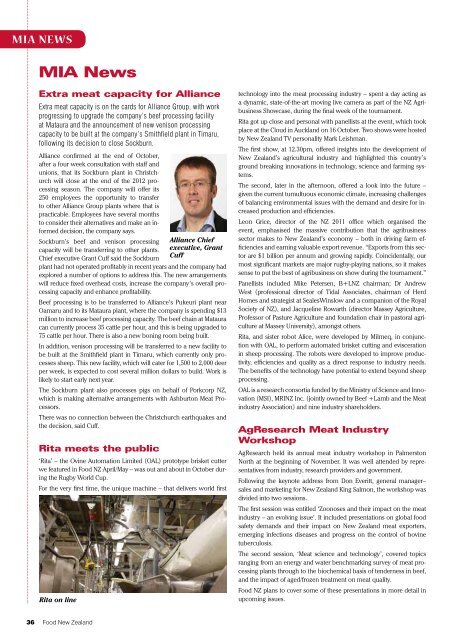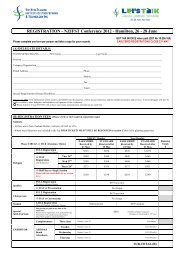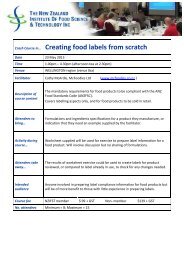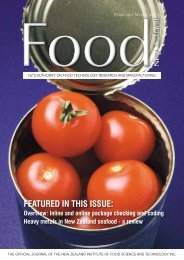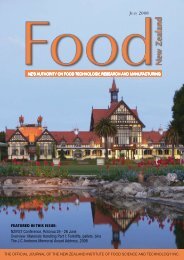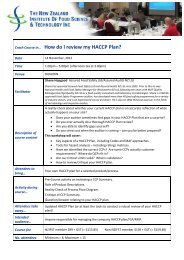FEATURED IN THIS ISSUE: - NZIFST - The New Zealand Institute of ...
FEATURED IN THIS ISSUE: - NZIFST - The New Zealand Institute of ...
FEATURED IN THIS ISSUE: - NZIFST - The New Zealand Institute of ...
You also want an ePaper? Increase the reach of your titles
YUMPU automatically turns print PDFs into web optimized ePapers that Google loves.
MIA NEWSMIA <strong>New</strong>sExtra meat capacity for AllianceExtra meat capacity is on the cards for Alliance Group, with workprogressing to upgrade the company’s beef processing facilityat Mataura and the announcement <strong>of</strong> new venison processingcapacity to be built at the company’s Smithfield plant in Timaru,following its decision to close Sockburn.Alliance confirmed at the end <strong>of</strong> October,after a four week consultation with staff andunions, that its Sockburn plant in Christchurchwill close at the end <strong>of</strong> the 2012 processingseason. <strong>The</strong> company will <strong>of</strong>fer its250 employees the opportunity to transferto other Alliance Group plants where that ispracticable. Employees have several monthsto consider their alternatives and make an informeddecision, the company says.Sockburn’s beef and venison processingcapacity will be transferring to other plants.Chief executive Grant Cuff said the Sockburnplant had not operated pr<strong>of</strong>itably in recent years and the company hadexplored a number <strong>of</strong> options to address this. <strong>The</strong> new arrangementswill reduce fixed overhead costs, increase the company’s overall processingcapacity and enhance pr<strong>of</strong>itability.Beef processing is to be transferred to Alliance’s Pukeuri plant nearOamaru and to its Mataura plant, where the company is spending $13million to increase beef processing capacity. <strong>The</strong> beef chain at Matauracan currently process 35 cattle per hour, and this is being upgraded to75 cattle per hour. <strong>The</strong>re is also a new boning room being built.In addition, venison processing will be transferred to a new facility tobe built at the Smithfield plant in Timaru, which currently only processessheep. This new facility, which will cater for 1,500 to 2,000 deerper week, is expected to cost several million dollars to build. Work islikely to start early next year.<strong>The</strong> Sockburn plant also processes pigs on behalf <strong>of</strong> Porkcorp NZ,which is making alternative arrangements with Ashburton Meat Processors.<strong>The</strong>re was no connection between the Christchurch earthquakes andthe decision, said Cuff.Rita meets the publicAlliance Chiefexecutive, GrantCuff‘Rita’ – the Ovine Automation Limited (OAL) prototype brisket cutterwe featured in Food NZ April/May – was out and about in October duringthe Rugby World Cup.For the very first time, the unique machine – that delivers world firstRita on linetechnology into the meat processing industry – spent a day acting asa dynamic, state-<strong>of</strong>-the-art moving live camera as part <strong>of</strong> the NZ AgribusinessShowcase, during the final week <strong>of</strong> the tournament.Rita got up close and personal with panellists at the event, which tookplace at the Cloud in Auckland on 16 October. Two shows were hostedby <strong>New</strong> <strong>Zealand</strong> TV personality Mark Leishman.<strong>The</strong> first show, at 12.30pm, <strong>of</strong>fered insights into the development <strong>of</strong><strong>New</strong> <strong>Zealand</strong>’s agricultural industry and highlighted this country’sground breaking innovations in technology, science and farming systems.<strong>The</strong> second, later in the afternoon, <strong>of</strong>fered a look into the future –given the current tumultuous economic climate, increasing challenges<strong>of</strong> balancing environmental issues with the demand and desire for increasedproduction and efficiencies.Leon Grice, director <strong>of</strong> the NZ 2011 <strong>of</strong>fice which organised theevent, emphasised the massive contribution that the agribusinesssector makes to <strong>New</strong> <strong>Zealand</strong>’s economy – both in driving farm efficienciesand earning valuable export revenue. “Exports from this sectorare $1 billion per annum and growing rapidly. Coincidentally, ourmost significant markets are major rugby-playing nations, so it makessense to put the best <strong>of</strong> agribusiness on show during the tournament.”Panellists included Mike Petersen, B+LNZ chairman; Dr AndrewWest (pr<strong>of</strong>essional director <strong>of</strong> Tidal Associates, chairman <strong>of</strong> HerdHomes and strategist at SealesWinslow and a companion <strong>of</strong> the RoyalSociety <strong>of</strong> NZ), and Jacqueline Rowarth (director Massey Agriculture,Pr<strong>of</strong>essor <strong>of</strong> Pasture Agriculture and foundation chair in pastoral agricultureat Massey University), amongst others.Rita, and sister robot Alice, were developed by Milmeq, in conjunctionwith OAL, to perform automated brisket cutting and eviscerationin sheep processing. <strong>The</strong> robots were developed to improve productivity,efficiencies and quality as a direct response to industry needs.<strong>The</strong> benefits <strong>of</strong> the technology have potential to extend beyond sheepprocessing.OAL is a research consortia funded by the Ministry <strong>of</strong> Science and Innovation(MSI), MR<strong>IN</strong>Z Inc. (jointly owned by Beef +Lamb and the Meatindustry Association) and nine industry shareholders.AgResearch Meat IndustryWorkshopAgResearch held its annual meat industry workshop in PalmerstonNorth at the beginning <strong>of</strong> November. It was well attended by representativesfrom industry, research providers and government.Following the keynote address from Don Everitt, general manager–sales and marketing for <strong>New</strong> <strong>Zealand</strong> King Salmon, the workshop wasdivided into two sessions.<strong>The</strong> first session was entitled ‘Zoonoses and their impact on the meatindustry – an evolving issue’. It included presentations on global foodsafety demands and their impact on <strong>New</strong> <strong>Zealand</strong> meat exporters,emerging infections diseases and progress on the control <strong>of</strong> bovinetuberculosis.<strong>The</strong> second session, ‘Meat science and technology’, covered topicsranging from an energy and water benchmarking survey <strong>of</strong> meat processingplants through to the biochemical basis <strong>of</strong> tenderness in beef,and the impact <strong>of</strong> aged/frozen treatment on meat quality.Food NZ plans to cover some <strong>of</strong> these presentations in more detail inupcoming issues.36Food <strong>New</strong> <strong>Zealand</strong>


